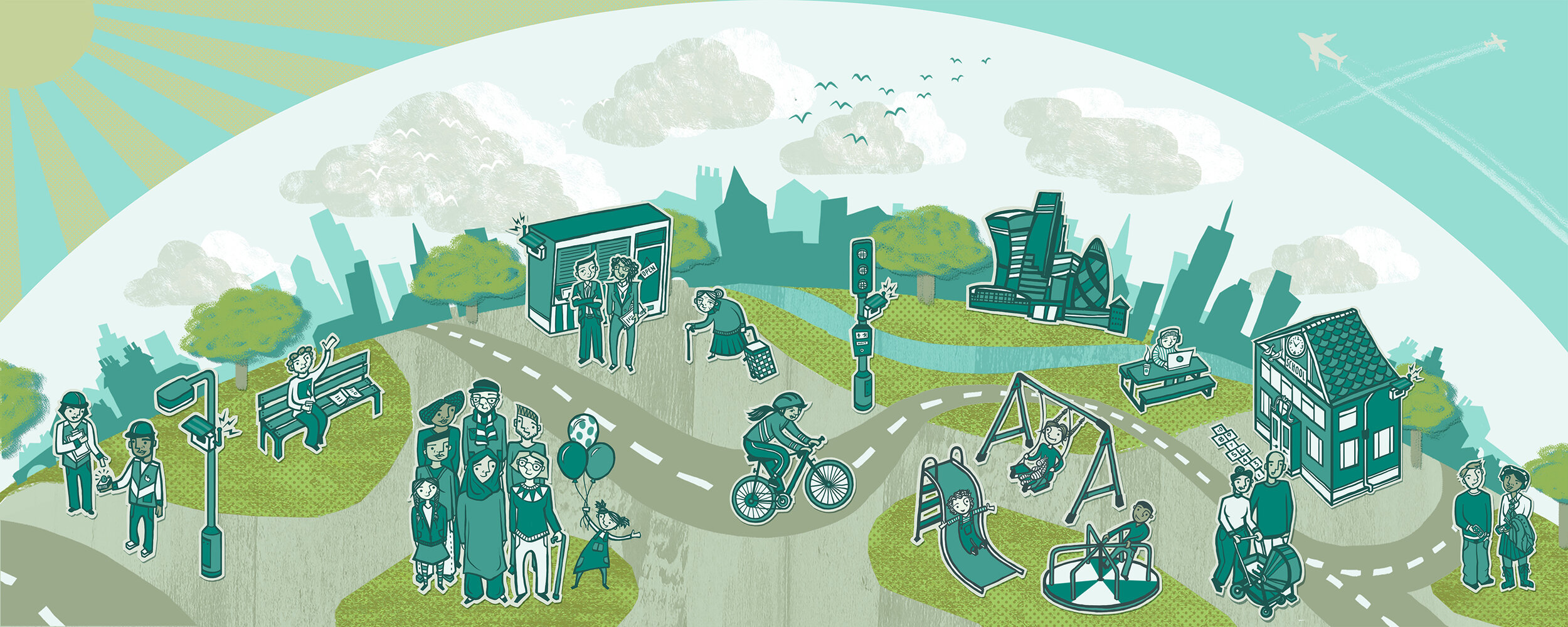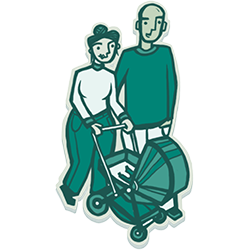
What can I do?
General
-
Write to your councillor, council leader, relevant council cabinet member and/or MP about air pollution in your area using this template or one of your choosing.
Join a campaign. Examples of charities to look for are Mums for Lungs, Global Action Plan, the Ella Roberta Foundation and Asthma + Lung UK.
Take part in air quality research, such as joining the Breathe London Community Project and the West London Healthy Home and Environment Study (WellHome).
Use your skills or qualifications to raise awareness about air pollution. For instance, if you are an artist, you can create a painting or a collection of paintings that communicate the impact of air pollution to others. If you have a legal background, you can use your knowledge to campaign for stricter regulations around air pollution.
-
Where possible, use more eco-friendly transportation methods such as walking, cycling, or public transport to reduce your contribution and exposure to air pollution. Air pollution is more harmful to children inside cars.
Avoid idling when driving. Instead, turn off your car engine to reduce emissions. This is particularly important whilst dropping off and picking up your children from nursery and school.
If you do have to drive, care for your car, as the state of its tyres and brakes also impacts the level of emissions it produces. When buying a new car, choose an electric vehicle as they produce no exhaust emissions when driven. If this is not an option, look for cars with the lowest emissions. Avoid older (+3 years) diesel cars and SUVs as they are more polluting.
Avoid using wood burners at home, as it creates pollution inside and outside the home. Wood burning releases more carbon dioxide than oil or gas for the same amount of heat! Homes with wood burners are at least three times more polluted than those without.
Improve the air quality inside your home. Avoid smoking indoors, burning wood, lighting candles, and incense. In addition, gas burners contribute to higher levels of pollution inside the home. When buying cleaning products, paints, furniture, fittings and flooring for your home, choose low emitting products.
Work to transition the energy supply of your home to renewable sources. You can find additional advice on this here.
Research and identify other ways in which you may be contributing to air pollution. This can include air travel, energy use, food choices and smoking.
-
Access live monitoring of air pollution data through networks such as Breathe London or subscribe to Airtext, an air pollution alert service. Check when air pollution levels are highest and lowest to plan activities such as going out for a walk/cycle, visiting the playground or exercising in the park. You can also use this data to choose the less polluted routes to walk/cycle.
Choose quieter streets when walking/cycling, avoiding areas with a lot of traffic. Walk on the inside of the pavement, keeping a distance from traffic.
Ventilate your home, opening windows several times a day and using extractor fans whilst cooking. If you live near a highly polluted area, check the local levels of air pollution before opening windows. Clean regularly to maintain low levels of dust (particulate matter).
Carer or parent
-
Write to your councillor, council leader, relevant council cabinet member and/or MP about air pollution in your area using this template or one of your choosing.
Join a campaign. Examples of charities to look for are Mums for Lungs, Global Action Plan, the Ella Roberta Foundation and Asthma + Lung UK.
Take part in air quality research, such as joining the Breathe London Community Project and the West London Healthy Home and Environment Study (WellHome).
Use your skills or qualifications to raise awareness about air pollution. For instance, if you are an artist, you can create a painting or a collection of paintings that communicate the impact of air pollution to others. If you have a legal background, you can use your knowledge to campaign for stricter regulations around air pollution.
Talk to your children’s school about air pollution and its effects on health. Global Action Plan has a great intervention toolkit with guidance on how to influence or implement actions to improve air quality around schools.
Take the opportunity of Clean Air Day (June 20th in 2024) and World Car Free Day (September 22nd 2024) to raise awareness about the health impact of air pollution in your community, at work etc. Ahead of Clean Air Day, work with parents and the administration at your children’s school to plan something for this special day.
Take part in family-friendly cycling events such as Kidical Mass (@KidicalMassLond on X) and more generally cycling events that promote inclusiveness (only a third of cycle journeys in London are made by women). Find out why here.
-
Where possible, use more eco-friendly transportation methods such as walking, cycling, or public transport to reduce your contribution and exposure to air pollution. Air pollution is more harmful to children inside cars.
Avoid idling when driving. Instead, turn off your car engine to reduce emissions. This is particularly important whilst dropping off and picking up your children from nursery and school.
If you do have to drive, care for your car, as the state of its tyres and brakes also impacts the level of emissions it produces. When buying a new car, choose an electric vehicle as they produce no exhaust emissions when driven. If this is not an option, look for cars with the lowest emissions. Avoid older (+3 years) diesel cars and SUVs as they are more polluting.
Avoid using wood burners at home, as it creates pollution inside and outside the home. Wood burning releases more carbon dioxide than oil or gas for the same amount of heat! Homes with wood burners are at least three times more polluted than those without.
Improve the air quality inside your home. Avoid smoking indoors, burning wood, lighting candles, and incense. In addition, gas burners contribute to higher levels of pollution inside the home. When buying cleaning products, paints, furniture, fittings and flooring for your home, choose low emitting products.
Work to transition the energy supply of your home to renewable sources. You can find additional advice on this here.
Research and identify other ways in which you may be contributing to air pollution. This can include air travel, energy use, food choices and smoking.
-
Access live monitoring of air pollution data through networks such as Breathe London or subscribe to Airtext, an air pollution alert service. Check when air pollution levels are highest and lowest to plan activities such as going out for a walk/cycle, visiting the playground or exercising in the park. You can also use this data to choose the less polluted routes to walk/cycle.
Choose quieter streets when walking/cycling, avoiding areas with a lot of traffic. Walk on the inside of the pavement, keeping a distance from traffic.
Ventilate your home, opening windows several times a day and using extractor fans whilst cooking. If you live near a highly polluted area, check the local levels of air pollution before opening windows. Clean regularly to maintain low levels of dust (particulate matter).
Young person or school students
-
Work with your parent/guardian to write to your councillor, council leader, relevant council cabinet member and/or MP about air pollution in your area using this template or one of your choosing.
Use your skills and/or special interests to raise awareness about air pollution. You can do so through many ways such as with essays, poetry, illustration, theatre, music, photography and videos.
Take part in air quality research or suggest to your school or parents to get involved in projects such as the Breathe London Community Project, the Schools’ Air Quality Monitoring for Health and Education (SAMHE) project and the West London Healthy Home and Environment Study (WellHome).
Talk to your parent(s)/guardian(s) about air pollution and its effects on health. You can suggest they read the information pack in the Breathe London website designed for Parent(s)/Carer(s).
Talk to your school about air pollution and its effects on health. Global Action Plan has a great intervention toolkit with guidance on how to influence or implement actions to improve air quality around schools.
-
Where possible, use more eco-friendly transportation methods such as walking, cycling, or public transport to reduce your contribution and exposure to air pollution.
Advocate for better indoor air quality in your house, suggesting to your parent(s)/guardian(s) to avoid smoking indoors, burning wood, lighting candles, incense and gas burners. You can also recommend the use of low emitting cleaning products, paints, furniture, fittings and flooring for your home.
-
Access live monitoring of air pollution data through networks such as Breathe London or subscribe to Airtext, an air pollution alert service. Check when air pollution levels are highest and lowest to plan activities such as going out for a walk/cycle, visiting the playground or exercising in the park. You can also use this data to choose the less polluted routes to walk/cycle.
Choose quieter streets when walking/cycling, avoiding areas with a lot of traffic. Walk on the inside of the pavement, keeping a distance from traffic.
Ventilate your home, opening windows several times a day and using extractor fans whilst cooking. If you live near a highly polluted area, check the local levels of air pollution before opening windows. Clean regularly to maintain low levels of dust (particulate matter).
Campaigner, advocate or volunteer
-
Campaign for your council/region to set a plan, establish interim targets, and set realistic, smart actions to achieve those targets to reduce air pollution locally. This plan should establish the pathway to meet the World Health Organisation air pollution guidelines.
Encourage schools and the council in your area to implement School Streets. You can read about successful case studies here.
Establish a local workforce or appoint a cabinet member to be the spokesperson for clean air in your council/region. This can ensure that air pollution issues are always represented and taken into account in policy making.
Raise awareness about air pollution, its effects on health and ways in which members of the community can contribute to its reduction, such as active travel, avoiding wood burning, etc.
Campaign for more cycle lanes in your council/region, to provide a safe and encouraging environment for active travel within the city.
Promote the improvement of public transport in your council/region.
Share this template with your community and encourage them to write to your counsellor and/or MP asking for specific actions to reduce air pollution.
Team up with an existing campaign. If you aren’t already connected, join one of the 60 Breathe London Community Groups across London. You can also connect with national air quality campaigns Mums for Lungs, Global Action Plan, the Ella Roberta Foundation, Asthma + Lung UK & Friends of the Earth
Add to our growing list of actions and recommendations here!
-
Share this list of actions different groups can take to reduce emissions and exposure to air pollution.
Encourage local businesses and organisations to pledge to reduce their emissions. This can be accomplished by:
Changing their energy supplier to renewable sources,
Encouraging staff to adopt active travel methods or take public transport,
Sponsoring a new Breathe London node near a school or another area of local importance
-
Access live monitoring of air pollution data through networks such as Breathe London or subscribe to Airtext, an air pollution alert service. Check when air pollution levels are highest and lowest to plan activities such as going out for a walk/cycle, visiting the playground or exercising in the park. You can also use this data to choose the less polluted routes to walk/cycle.
Choose quieter streets when walking/cycling, avoiding areas with a lot of traffic. Walk on the inside of the pavement, keeping a distance from traffic.
Encourage your community to ventilate your home, opening windows several times a day and using extractor fans whilst cooking. If you live near a highly polluted area, check the local levels of air pollution before opening windows. Clean regularly to maintain low levels of dust (particulate matter).
Teacher or school administrator
-
Teach students about air quality, its health effects, and ways to improve it. Global Action Plan has produced resource packs and educational activities that can be used to engage students with the issue of air pollution. You can check these materials here.
Write to your councillor, council leader and/or MP about air pollution in your area using this template or one of your choosing.
Run school events on the topic of air pollution and encourage everyone to take part.
Join a campaign. Examples of charities to look for are Mums for Lungs, Global Action Plan, the Ella Roberta Foundation, Asthma + Lung UK & Friends of the Earth
Get the school involved in air quality research, in projects such as the Breathe London Community Project and the Schools’ Air Quality Monitoring for Health and Education (SAMHE) project.
-
Reduce the volume of traffic outside the school. This can be done by implementing a school street, which restricts the access of motorised vehicles in the area during school drop-off and pick-up. Information on how to implement a school street can be found here.
Encourage teachers, parents and students to use eco-friendly modes of transport methods such as walking, cycling, or public transport.
Use low emission cleaning products in school premises. This is also recommended when choosing paints, furniture, fittings, or flooring.
Work to transition the energy supply of the school buildings to renewable sources.
Research and identify other ways in which you may be contributing to air pollution. This can include air travel, energy use, food choices and smoking.
-
Ventilate the classrooms regularly. This can be done by opening windows several times a day. In winter, smaller window openings are sometimes sufficient to achieve adequate ventilation. However, restrict the opening of doors/windows that face the drop-off/pick-up areas during school drop-off and pick-up, to reduce the infiltration of pollutants from cars. A good guide for classroom ventilation can be found here.
If the school is near a highly polluted area, check the local levels of air pollution before opening windows and planning activities outdoors. Air quality data can be found from networks such as the Breathe London Community Project or from Defra-UK. If classrooms are mechanically ventilated, ensure that systems are properly maintained.
Introduce hedges along the boundary of the school to serve as a barrier between the road and the school. This can reduce the amount of pollutants from traffic emissions to which school children are exposed to.
When planning new school buildings, choose locations away from main roads.
If possible, monitor the air quality in classrooms using low-cost sensors. Tracking the levels of different pollutants in the room can help improve the ventilation in your classroom. If monitoring shows that ventilation in the classroom is insufficient, HEPA filters can be used to remove a portion of the pollutants from the air.
Councillor or policymaker
-
Campaign for your council/region to set a plan and establish interim targets to reduce air pollution locally. This plan should establish the pathway to meet the World Health Organisation air pollution guidelines.
Encourage schools in your council/region to implement School Streets. You can read about successful case studies here.
Establish a local workforce or appoint a cabinet member to be the spokesperson for clean air in your council/region. This can ensure that air pollution issues are always represented and taken into account in policy making.
Raise awareness about air pollution, its effects on health and ways in which members of the community can contribute to its reduction, such as active travel, avoiding wood burning, etc.
Campaign for more cycle lanes in your council/region, to provide a safe and encouraging environment for active travel within the city.
Promote the improvement of public transport in your council/region.
Add to Breathe London’s growing list of actions and recommendations here!
-
Use low emission cleaning products in public buildings. This is also recommended when choosing paints, furniture, fittings, or flooring.
Work to transition the energy supply of public buildings to renewable sources.
Encourage employees to take more eco-friendly transportation methods such as walking, cycling, or public transport.
-
Maintain good indoor air quality in public buildings. This can be done by opening windows several times a day. If the building is located near a polluted area, check the local levels of air pollution before opening windows. Clean regularly to maintain low levels of dust (particulate matter) indoors. If you are worried about window opening increasing energy costs, low-cost sensors can be used to monitor indoor air quality. With these sensors, you can identify when it is necessary to open windows. If outdoor air is consistently poor, you may consider the use of a HEPA filter, an air cleaning device that removes particulate matter and other pollutants from the air. More guidance on improving air quality in business venues here.
Health worker
-
Explore Greener Practice resources and consider joining your local group to find engaged colleagues and collaborate together to improve air quality.
Connect with Greener NHS representatives or identify the key contacts in your area responsible for air quality, population health or health inequalities.
Review examples of how GPs or health care facilities have helped reduce air pollution emissions and exposures: Islington Primary Care for Clean Air and Breathe London Community Programme groups: Beckton Community Air Quality Group, Hounslow Respiratory Support Group and The Heron Practice. Connect with Global Action Plan or Breathe London to see how you can get involved.
Apply or encourage your supervisors to apply to trusts and charities to fund environmental initiatives at your practice or facility. An example could be purchasing a Breathe London node to learn more about local air quality and how to address specific pollution sources.
Visit Global Action Plan’s Health Knowledge Hub for more recommendations on how health care workers can take action on air pollution.
-
Work with your facilities and operations team and local authority contacts, to reduce the volume of traffic and idling outside your buildings.
This can be done by implementing an ICS Framework or Clean Air Hospital Framework in partnership with Global Action Plan, which can help restrict the access of motorised vehicles in the area.
Encourage staff to use eco-friendly modes of transport methods such as walking, cycling, or public transport.
Support transitioning the energy supply of the building to renewable sources.
-
Access live monitoring of air pollution data through networks such as Breathe London to learn more about local air quality, check when air pollution levels are highest and lowest and understand how to best target your actions.
Encourage colleagues and patients to subscribe to LondonAir air pollution forecast alerts and understand health advice about how to respond to these alerts.
Remind colleagues and patients to consider indoor air quality as well, with more tips on how to maintain good indoor air quality here.
For GP practices and A&E, ask about how air quality alerts are communicated and used in your setting.
Help maintain good indoor air quality in public buildings. This can be done by opening windows several times a day. If the building is located near a polluted area, check the local levels of air pollution before opening windows. Clean regularly to maintain low levels of dust (particulate matter) indoors. If you are worried about window opening increasing energy costs, low-cost sensors can be used to monitor indoor air quality. With these sensors, you can identify when it is necessary to open windows. If outdoor air is consistently poor, you may consider the use of a HEPA filter, an air cleaning device that removes particulate matter and other pollutants from the air. More guidance on improving air quality in business venues here.
Encourage colleagues and patients to choose quieter streets when walking/cycling, avoiding areas with a lot of traffic. Walk on the inside of the pavement, keeping a distance from traffic.
Individual or carer of someone with a health condition
-
Write to your councillor, council leader and/or MP about air pollution in your area using this template or one of your choosing.
Consider participating in specific research studies aimed at understanding how air pollution impacts individuals with certain health conditions.
Join a campaign or group centred around those living with specific health conditions, such as Asthma Lung + UK, British Heart Foundation, Macmillan Cancer, or smaller local groups like Hounslow Respiratory Support Group (Breathe London Community Group) or the Islington Better Breathing Group.
Take part in air quality research, such as joining the Breathe London Community Project and the West London Healthy Home and Environment Study (WellHome).
-
Where possible, use eco-friendly modes of transport such as walking, cycling, or public transport to reduce your contribution to air pollution.
Avoid idling when driving. Instead, turn off your car engine to reduce emissions.
If you do have to drive, care for your car, as the state of its tyres and brakes also impacts the level of emissions it produces. When buying a new car, choose an electric vehicle as they produce no exhaust emissions when driven. If this is not an option, look for cars with the lowest emissions. Avoid SUVs as they are the most polluting cars.
Avoid using wood burners at home, as it creates pollution inside and outside the home. Wood burning releases more carbon dioxide than oil or gas for the same amount of heat! Homes with wood burners are at least three times more polluted than those without.
Improve the air quality inside your home. Avoid smoking indoors, burning wood, lighting candles, incense, and gas burners. When buying cleaning products, paints, furniture, fittings, and flooring for your home, choose low emitting products.
Research and identify other ways in which you may be contributing to air pollution. This can include air travel, energy use, food choices and smoking.
-
Access live monitoring of air pollution data through networks such as Breathe London, and check when air pollution levels are highest and lowest to plan activities such as going out for a walk/cycle or exercising in the park. You can also use this data to choose the less polluted routes to walk/cycle.
Subscribe to LondonAir air pollution forecast alerts and avoid going out or strenuous outdoor activity during high pollution alerts. Also consider indoor air quality (see final bullet point).
Choose quieter streets when walking/cycling, avoiding areas with a lot of traffic. Walk on the inside of the pavement, keeping a distance from traffic.
When driving, keep your car windows closed, particularly when you are driving in slow-moving traffic.
Ventilate your home, opening windows several times a day and using extractor fans whilst cooking. If you live near a highly polluted area, check the local levels of air pollution before opening windows. Clean regularly to maintain low levels of dust (particulate matter). You can monitor air quality inside your home using low-cost sensors. With these sensors, you can identify when it is necessary to open windows. If outdoor air is consistently poor, you may consider the use of a HEPA filter. A HEPA filter is an air cleaning device that removes particulate matter and other pollutants from the air. More tips on how to maintain good indoor air quality here.
Local business or Infrastructure Organisation
-
Join the Alliance for Clean Air.
Write to your councillor, council leader and/or MP about air pollution in your area using this template or one of your choosing.
Join a campaign. Examples of charities to look for are Mums for Lungs, Global Action Plan, the Ella Roberta Foundation and Asthma UK.
Take part in air quality research, such as joining the Breathe London Community Project and the West London Healthy Home and Environment Study (WellHome).
-
When receiving deliveries, encourage drivers to stop idling and turn off their engine whilst unloading. This reduces the amount of vehicle emissions in your premises.
Use low emission cleaning products in your premises. This is also recommended when choosing paints, furniture, fittings, or flooring.
Work to transition the energy supply of your building to renewable sources.
Encourage employees to take more eco-friendly transportation methods such as walking, cycling, or public transport. Employers can sign up to the Cycle to Work scheme to encourage staff cycling: https://www.cyclescheme.co.uk/employers
Research and identify other ways in which your business may be contributing to air pollution. This can include air travel, energy use, choice of supplies, etc.
-
Maintain good indoor air quality in your premises. You can do this by:
Opening windows several times a day and using extractors fans whilst cooking.
If your business is located near a polluted area, check the local levels of air pollution before opening windows.
Clean regularly to maintain low levels of dust (particulate matter) in your premises.
If you are worried about window opening increasing your energy costs, you can monitor air quality in your premises using low-cost sensors. With these sensors, you can identify when it is necessary to open windows.
If outdoor air is consistently poor, you may consider the use of a HEPA filter, an air cleaning device that removes particulate matter and other pollutants from the air.
More guidance on improving air quality in buildings here.

















